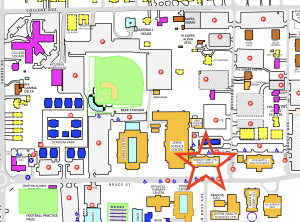Dr. Edmond E. Griffin Planetarium
The Dr. Edmond E. Griffin Planetarium, located on the University of Central Arkansas Campus in the Conway Corporation Center for the Sciences, serves as an astronomy and science education resource center for central Arkansas. The planetarium is part of the outreach component of the Department of Physics, Astronomy, and Engineering, and as such, it supports astronomy teaching on campus, as well as, offers planetarium shows to school groups and the general public.
There are no more field trip slots available for the fall 2025 semester.
*Field Trip Information – Click Here*
Hardware upgrades will occur early in the spring 2026 semester. Once we have a good understanding of the time-line for those upgrades we will be posting available field trip slots for the spring.
Fall 2025 Public Shows
The one-hour shows are Fridays and Saturdays starting at 7:00pm. Entry to the planetarium begins ten minutes before the shows. NO admittance once the shows start. Seating for Public Shows is on a first-come basis with maximum possible capacity of 94. Please be aware that no food or drink is allowed in the Conway Corporation Center for the Sciences building. Admission is currently free. Donations to the Griffin Planetarium through the Secure Giving link are encouraged.
August 22 and 23, 7pm: Big Astronomy: People, Places, Discoveries
“Highlights the telescopes and the diverse people who enable discoveries at world-class observatories in Chile.”

August 29 and 30, 7pm: Unveiling the Invisible Universe
“For thousands of years the humans observed the light coming from the night sky with their eyes. In the beginning of the 17th century, the invention of the telescope by Galileo revolutionized our knowledge of the Universe. Finally, in the 20th century with the advent of rockets, it became possible to go above the earth’s atmosphere and observe X-ray and gamma ray radiation which are the marks of the hot and violent Universe. But it is not only light that can give us information about the cosmos. Neutrinos and cosmic rays also provide vital information. Finally, the detection by the LIGO experiment of gravitational waves from two merging black holes opened a new window in astrophysics. This video presents images of the cosmos as revealed by all these different messengers.”

September 5 and 6, 7pm: Invaders of Mars!
“Under the care of Emmy award winning space artist, Don Davis, this beautifully crafted show highlights our ongoing exploration of Mars. We explore the Martian surface as seen by Earth’s various spacecraft “invaders” and use the data gathered to explore the red planet as only CGI can. We fly over the great chasms, canyons and volcanoes, descend amid the icy Martian polar cap, and withstand swirling dust devils. Blinded by the planet-wide storm that often engulf this world, we emerge with a new perspective on the red planet Mars. Includes an optional five-minute end sequence of stereo imagery. Narrated by Tom Baker, of the BBC’s Dr. Who. Winner of four Telly Awards.”

September 12 and 13, 7pm: The Sun Our Living Star
“The Sun has shone on our world for four and a half billion years. The light that warms our skin today has been felt by every person who has ever lived. It is our nearest star and our planet’s powerhouse, the source of the energy that drives our winds, our weather and all life. The passage of the Sun’s fiery disc across the sky — day by day, month by month — was the only way to keep track of time for countless past civilizations. Don’t be fooled by the terminology; although it is a typical dwarf star, the Sun consumes 600 million tons of hydrogen each second and is 500 times as massive as all the planets combined. Discover the secrets of our star in this planetarium show and experience never-before-seen images of the Sun’s violent surface in immersive fulldome format.“

September 19 and 20, 7pm: Stars of the Pharaohs
“Travel to ancient Egypt to see how science was used to tell time, make a workable calendar, and align huge buildings. You’ll learn about the connection the ancient Egyptians felt with the stars and various astronomical phenomena, and experience some of the most spectacular temples and tombs of the ancient world recreated in all of their original splendor. Telly Award winner. Narrated by John Rhys-Davies, of the Indiana Jones films and The Lord of the Rings films.”

September 26 and 27, 7pm: From Earth to the Universe
“The night sky, both beautiful and mysterious, has been the subject of campfire stories, ancient myths and awe for as long as there have been people. A desire to comprehend the Universe may well be humanity’s oldest shared intellectual experience. Yet only recently have we truly begun to grasp our place in the vast cosmos. To learn about this journey of celestial discovery, from the theories of the ancient Greek astronomers to today’s grandest telescopes, we invite you to experience From Earth to the Universe. This stunning, 30-minute voyage through space and time conveys, through sparkling sights and sounds, the Universe revealed to us by science. Viewers can revel in the splendor of the worlds in the Solar System and our scorching Sun. From Earth to the Universe takes the audience out to the colorful birthplaces and burial grounds of stars, and still further out beyond the Milky Way to the unimaginable immensity of myriad galaxies. Along the way, the audience will learn about the history of astronomy, the invention of the telescope, and today’s giant telescopes that allow us to probe ever deeper into the Universe.“

October 3 and 4, 7pm: Mayan and Aztec Archaeoastronomy
“In a feast of colours and sounds, Mayan Archaeoastronomy: Observers of the Universe makes a
tour of 6 Mayan temples: San Gervasio, Chichen Itzá, Uxmal, Edzná, Palenque and Bonampak
where the spectator dives into a Mayan world of knowledge about the importance of the
onentations of its temples in relation to the movement of some stars like the sun, the Moon and
Venus
Through impressive immersive scenarios. “Mexica Archaeoastronomy: between space and
time” illustrates the important role played by astronomical observation for the evolution of pre-
Hispanic cultures in central Mexico. The Mexicas used the calendrical and astronomica!
knowledge inherited by their predecessor cultures to found the capital of their empire:
lenochtitlan. Vibrant colors, shapes and sounds transport the viewer to one or the most important
cultures that, to this day, still lives of the Mexican people.”


October 10 and 11, 7pm: River of Bears
“River of Bears is about the legendary McNeil River Alaska State Game Sanctuary. During the summertime it hosts the largest congregation of brown bears in the world. Bears come from hundreds of miles to the sanctuary to mate, raise cubs, and dine on the abundant sedge grass and salmon. On a typical day in July over fifty bears can be seen at the McNeil River falls, feasting on salmon desperately swimming upstream to spawn. The show tells the remarkable story of these bears as they prepare for the coming harsh Alaska winter, and the visitors and scientists who come every summer to see them.”

October 24 and 25, 7pm: Experience the Aurora
“Over seven months in the Arctic Circle, our crews captured time-lapse images of the Aurora Borealis with high resolution digital SLR cameras outfitted with fisheye lenses. The results are spectacular. For the first time the aurora has been captured as it was meant to be experienced, as a display that covers the entire sky. This immersive show shares the science behind the aurora and tells the story of our quest to find and photograph the aurora for wraparound display in fulldome theaters. Winner of 2 Telly Awards.”

October 31 and November 1, 7pm: One Sky
“In an effort to foster greater understanding of humanity’s connection to the sky, the One Sky Project, which is led by the ‘Imiloa Astronomy Center, sponsored by the Thirty Meter Telescope, and supported by the California Academy of Sciences, the Franklin Institute, NSF’s NOIRLab, and the Thirty Meter Telescope, has released a compiled feature film focusing on cultural and Indigenous astronomy. The project is an international collaboration that seeks to build cross-cultural connections and increase understanding of different Indigenous perspectives while demonstrating how our one sky connects us all.”

November 7 and 8, 7pm: Supermassive Black Holes, Uncovering the Invisible
“Leading scientists in observational and theoretical studies of black holes and galaxies, industrial experts in cutting-edge big technologies, and professionals in science dissemination have been brought together to set up research projects which will combine the latest state-of-the-art observations, numerical simulations and innovative analytic tools to compare theory with observation, and shed light on the physics of black hole formation in the context of galaxy evolution. This planetarium show presents the environments of the black holes in an impressive and understandable way to the audience.”

November 14 and 15, 7pm: Phantom of the Universe
“From the journey of protons racing through the world’s largest particle collider in Europe to up-close views of the Big Bang and emergent cosmos, Phantom of the Universe is designed to immerse audiences in the search for dark matter. A collaboration of Lawrence Berkeley National Lab, University of Texas at Arlington, Michigan State University, IFIC at University of Valencia, as well as other institutions. It is narrated by Oscar-winning actress, Tilda Swinton.”

November 21 and 22, 7pm: Secret Lives of Stars
“Not all stars are created Equal. Some are massive. Others are tiny; almost insignificant. The specific characteristics of a star will determine what type of life it will lead, how long it might live and even the type of death it will die. We will witness the amazing variety of stars and peer into their secret lives. Narrated by Sir Patrick Stewart of TV’s Star Trek the Next Generation and the X-men films. Winner of 4 Telly Awards.”

December 5 and 6, 7pm: Out There, The Quest for Extrasolar Worlds
“For thousands of years, mankind thought that the Earth was the center of the Universe. Thanks to our curiosity, imagination and urge to explore, we now know that planets like our Earth are nothing special in the cosmos. The Sun is just one ordinary star among hundreds of billions in our galaxy, the Milky Way. With the world’s most powerful telescopes, we are able to explore more and more of the Universe. What we have found so far has surpassed even the wildest expectations of scientists as well as authors of science fiction. Most stars have planets — it turns out they are more common than we thought.
A huge diversity of different worlds is out there, just waiting to be discovered.“

SUPPORT GRIFFIN:
ABOUT:
Contact:
Department of Physics and Astronomy
University of Central Arkansas phone: 501.450.5900
Conway, AR 72035 fax: 501.852.2286
Staff:
Dr. Scott Austin saustin@uca.edu
Director of Astronomical Facilities
Associate Professor of Astronomy and Physics
Department of Physics and Astronomy
University of Central Arkansas phone: 501.450.5907
Conway, AR 72035 fax: 501.852.2286
History:
From 1987 to 2015, the original UCA planetarium that was located in Lewis Science Center used an electromechanical planetarium projector and a thirty-foot dome to simulate the sky as seen from the surface of the Earth.
The current digital planetarium in the Conway Corporation Center for the Sciences consists of 94 seats under a forty-foot diameter dome onto which an Evans & Sutherland dual projector Digistar 7 system creates a virtual universe. The universe can now be seen from other locations in the universe, such as, in orbit around Saturn, near a binary star system in our galaxy, or from a galaxy a several million light years from the Earth.
The building of a new planetarium was supported by Dr. Sue Griffin, a world-class neuroscientist at the University of Arkansas for Medical Sciences, and named in memory of her husband Dr. Ed Griffin, a long-time faculty member, chair of the UCA Biology Department, and astronomy enthusiast.




